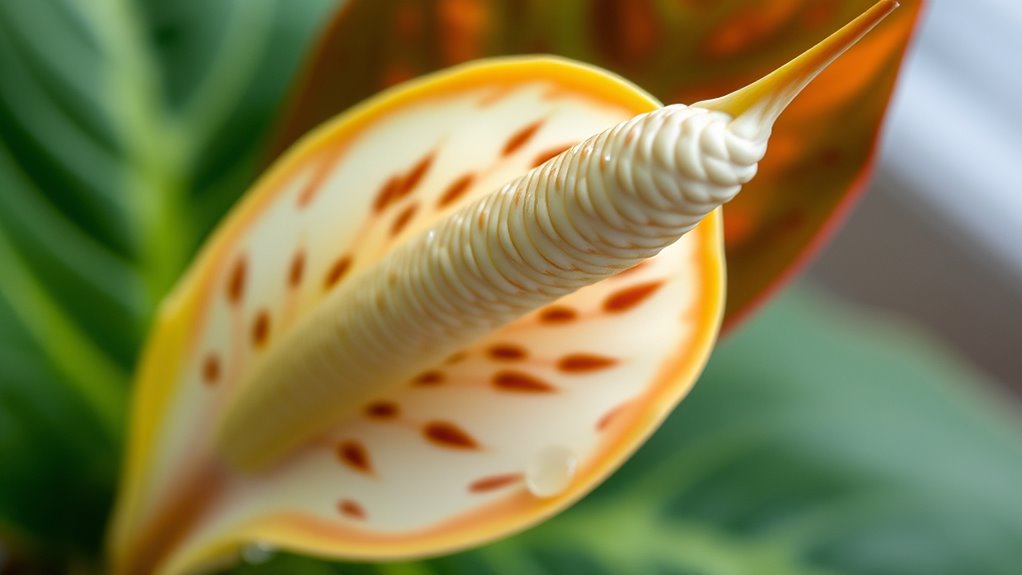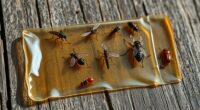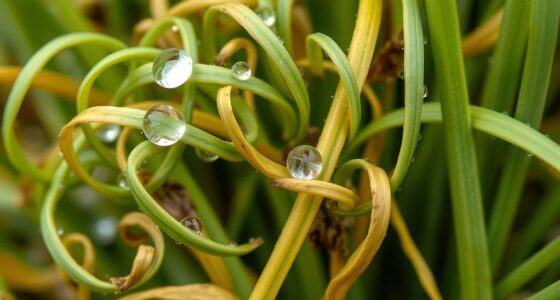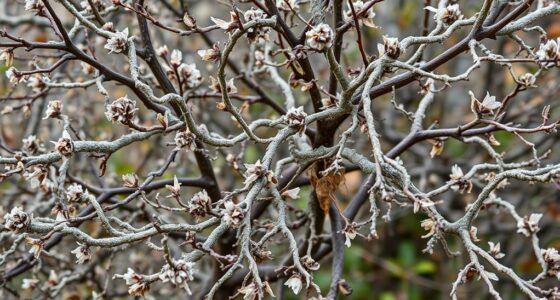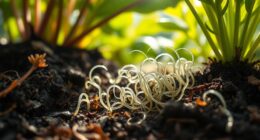If your anthurium’s spadix turns brown, it could be from natural aging, watering issues, or a fungal infection. Aging causes gradual, symmetrical browning and softer leaves, while over- or underwatering leads to sudden, uneven browning and browning tips. Fungal infections often cause fuzzy spots or mold on the plant. To keep your plant healthy, it’s important to understand these causes—exploring further can help you address the problem effectively.
Key Takeaways
- Aging Anthurium naturally shows gradual browning at the tips of the spadix, often symmetrical and accompanied by duller leaf textures.
- Overwatering causes root rot, leading to uneven browning and soft, mushy spots on the spadix and leaves.
- Fungal infections typically result in irregular discoloration, fuzzy mold, or slimy patches on the spadix and plant surface.
- Insufficient light or excessive sunlight can scorch the spadix, causing browning or burning edges.
- Proper care includes maintaining balanced watering, good drainage, optimal humidity, and monitoring for signs of pests or fungi.
Recognizing Normal Aging in Your Anthurium
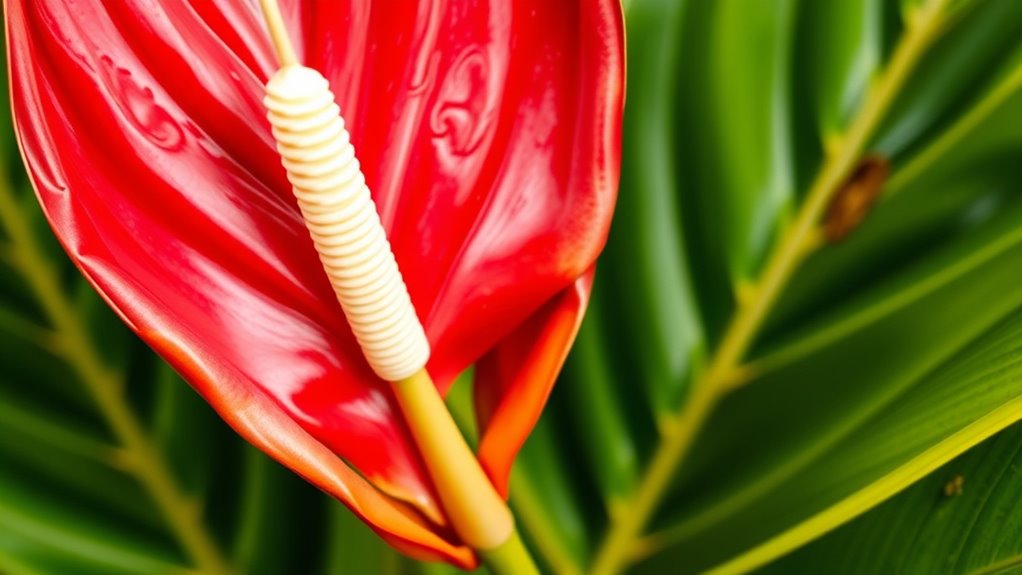
As your anthurium ages, it’s natural for some parts of the plant to change. You might notice the flower color shifting from vibrant reds or pinks to softer shades, signaling healthy aging. The leaf texture can also become slightly duller or more leathery, which is typical as the plant matures. These changes aren’t signs of trouble but rather normal indicators that your anthurium is progressing through its natural life cycle. You may see fewer flowers over time, but new blooms can still appear. Keep an eye on these subtle shifts—they help you understand your plant’s health and age. Recognizing these normal aging signs can help you better tailor your care routine to support healthy growth during each stage. Additionally, understanding the plant aging signs can guide you in providing appropriate watering and fertilizing adjustments as your anthurium matures. Being aware of AI-driven plant care insights can further enhance your ability to monitor and support your plant’s development.
How Watering Habits Impact the Spadix
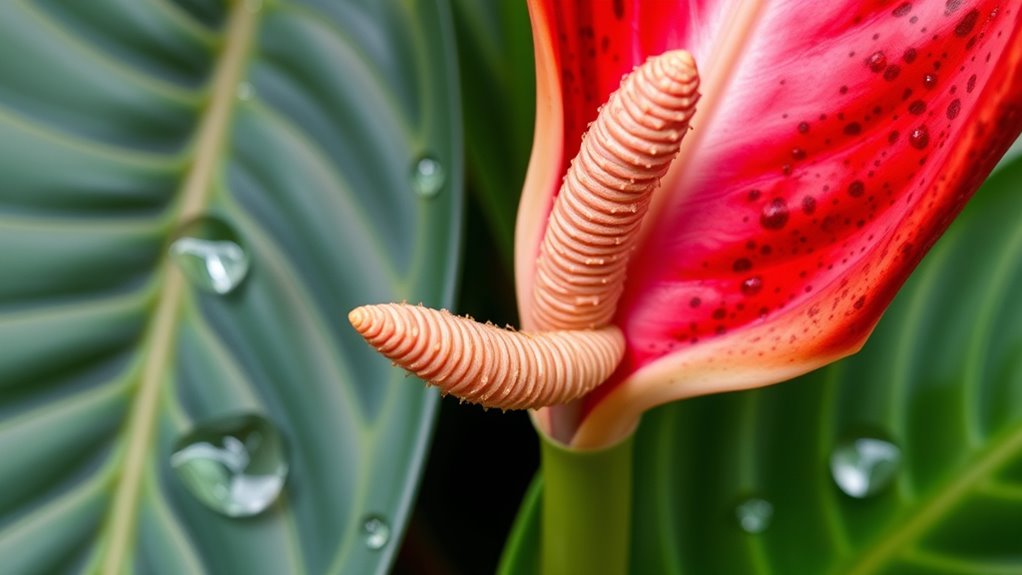
Proper watering is essential for maintaining a healthy anthurium spadix, as overwatering or underwatering can cause it to turn brown or wilt. If your soil drains poorly, excess water may sit around the roots, leading to root rot and browning of the spadix. Make certain your pot has good drainage and avoid letting the plant sit in water. Conversely, underwatering can cause dehydration, making the spadix dry out and brown. Humidity levels also play a role; higher humidity helps the plant retain moisture, reducing the risk of browning caused by stress. Water your anthurium consistently, keeping the soil moist but not soggy, and adjust watering frequency based on your environment’s humidity and soil drainage. Proper watering habits support a vibrant, healthy spadix. Ensuring optimal watering practices aligns with vetted Halloween product reviews, which emphasize the importance of plant care for overall health. Additionally, monitoring plant health indicators can help you detect early signs of watering issues and address them promptly. Maintaining awareness of plant stress responses can further aid in preventing browning and promoting a thriving, beautiful spadix.
Identifying Signs of Fungal Infections
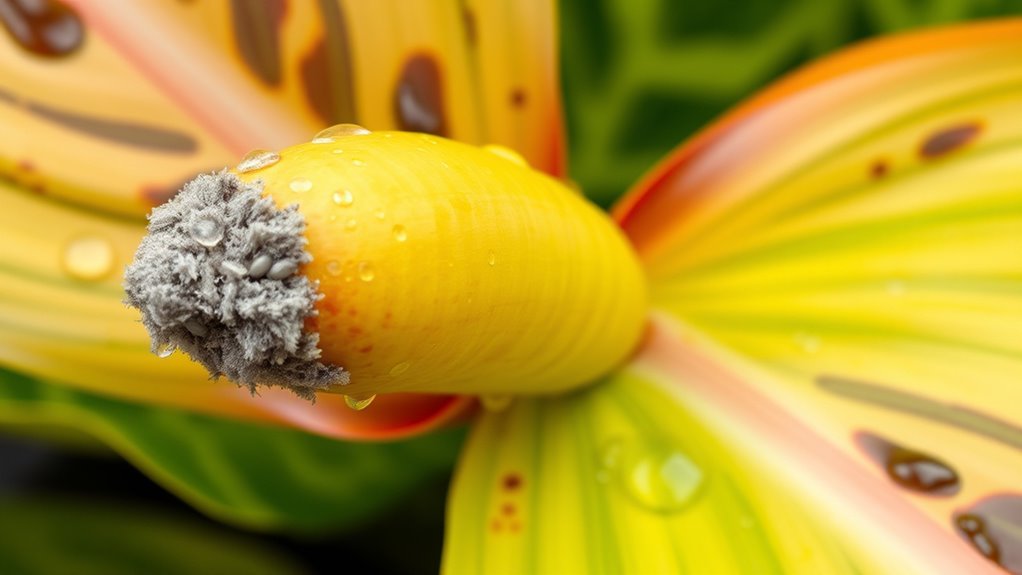
Even with good watering practices, fungal infections can still threaten your anthurium’s health. You need to learn fungal symptom identification to catch issues early. One clear sign is spadix discoloration, where the normally vibrant spadix turns dull, brown, or black. You might also notice a fuzzy or moldy growth on the surface, which indicates fungal presence. Keep an eye out for soft, mushy spots or a slimy texture, especially if they appear suddenly. Fungal infections often cause irregular patches or spots that spread quickly. Recognizing these symptoms early helps you take the right steps to treat and save your anthurium. Regular monitoring and understanding fungal infections can help you maintain a healthy plant environment. Additionally, maintaining proper air circulation around your plant can reduce humidity levels that promote fungal growth. Proper watering techniques and avoiding excess moisture are also crucial in preventing fungal development.
Differentiating Between Natural and Problematic Browning
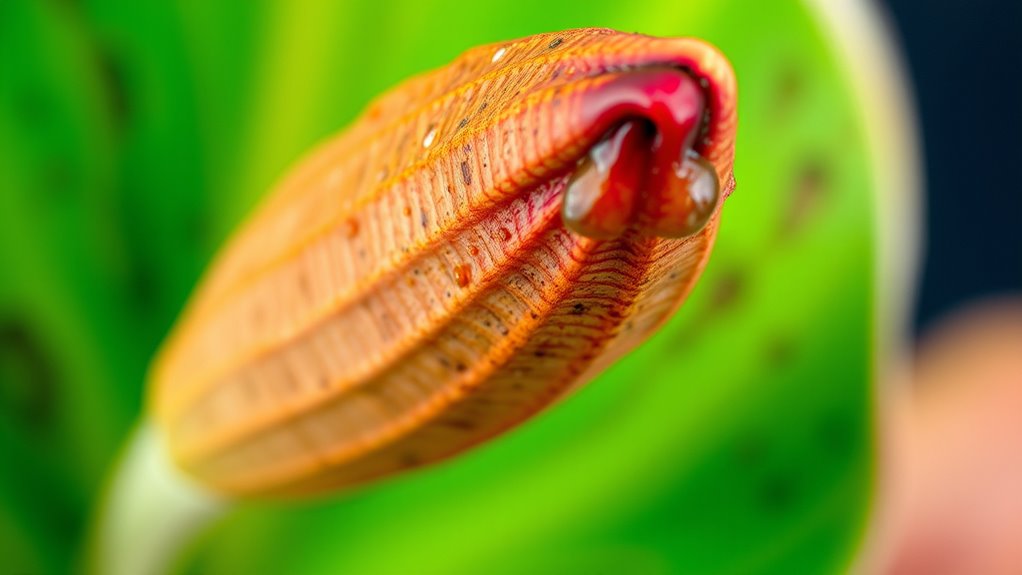
You need to learn how to tell if browning on your anthurium is normal or a sign of trouble. Natural aging usually causes gradual, even browning, while water stress or fungal issues often show more sudden or uneven spots. Recognizing these differences helps you decide whether to adjust care or take action. Additionally, understanding plant health indicators can guide you in maintaining a thriving, healthy anthurium. Monitoring environmental impacts might seem unrelated, but choosing the right conditions can reflect your plant’s ability to stay healthy and vibrant, much like recognizing healthy plant characteristics.
Natural Aging Signs
As an anthurium matures, its spadix naturally begins to turn brown at the tips or along the edges, which is usually a sign of aging rather than a problem. During this process, you’ll notice the flower color gradually shifting from vibrant to more subdued hues, indicating the plant is reaching the end of its bloom cycle. Additionally, the leaf texture may become slightly less glossy and more matte, reflecting natural aging. This browning isn’t cause for concern if it occurs gradually and symmetrically. Keep an eye on these subtle changes, and remember that natural aging typically affects the flower and leaf appearance without spreading or causing other issues. Understanding these signs helps you care for your anthurium appropriately as it matures.
Water Stress Indicators
When anthuriums’ spadix turns brown, it’s important to determine whether the browning results from natural aging or water stress. Water stress can cause browning that looks similar but is driven by improper watering or soil conditions. Check your soil pH—if it’s too high or low, it can hinder nutrient uptake, stressing the roots. Healthy roots are white and firm; if they’re brown, mushy, or foul-smelling, your plant is likely suffering from water-related issues. Overwatering can suffocate roots, while underwatering causes dehydration, both leading to browning. By inspecting root health and adjusting watering habits, you can differentiate water stress from natural aging. Proper soil pH management and attentive watering are key to keeping your anthurium’s spadix vibrant. Regular monitoring of plant health indicators helps prevent issues before they become severe, especially considering the importance of maintaining optimal air quality around your plant.
Fungal Infection Clues
Fungal infections often cause browning on anthurium spadix that can resemble natural aging but usually have distinct signs. You’ll notice spore development, tiny dust-like particles on the surface or near the browning areas, indicating fungal growth. Unlike natural browning, which stays confined and progresses gradually, fungal issues often cause irregular discoloration and leaf discoloration around the affected area. You may see patches of darkened tissue, wilting, or soft spots on the spadix, signaling infection. If you observe a fuzzy or mold-like coating along with browning, it’s a strong sign of a fungal problem. Promptly inspecting for spore development and leaf discoloration helps you differentiate between aging and infection, allowing for targeted treatment and preventing further damage. Regular monitoring and proper plant care practices can also help prevent fungal issues from developing.
Common Environmental Factors Affecting Your Plant
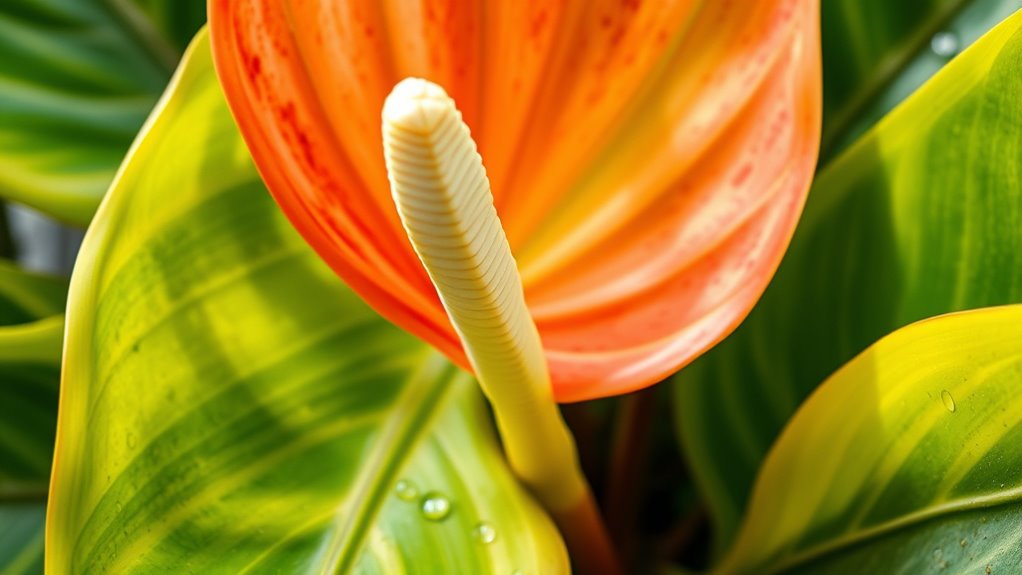
Environmental factors play a significant role in the health of your anthurium, especially when it comes to its spadix turning brown. One key factor is soil pH; if the soil is too acidic or alkaline, your plant can struggle to absorb nutrients, causing stress and browning. Test and adjust the soil pH to keep it between 5.5 and 6.5 for *ideal* growth. Sunlight exposure also matters—too much direct sunlight can scorch the leaves and spadix, while too little light hampers growth and flowering. Place your anthurium in bright, indirect light to promote healthy development. Being mindful of these environmental factors helps *guarantee* your plant remains vibrant and prevents unnecessary browning of the spadix. Additionally, monitoring storage conditions such as humidity and temperature can help prevent stress and promote overall plant health. Proper watering habits are essential, as overwatering or underwatering can also lead to browning and other issues. Ensuring good air circulation around your plant can further reduce the risk of fungal infections that may cause browning.
Preventative Measures for Healthy Spadices
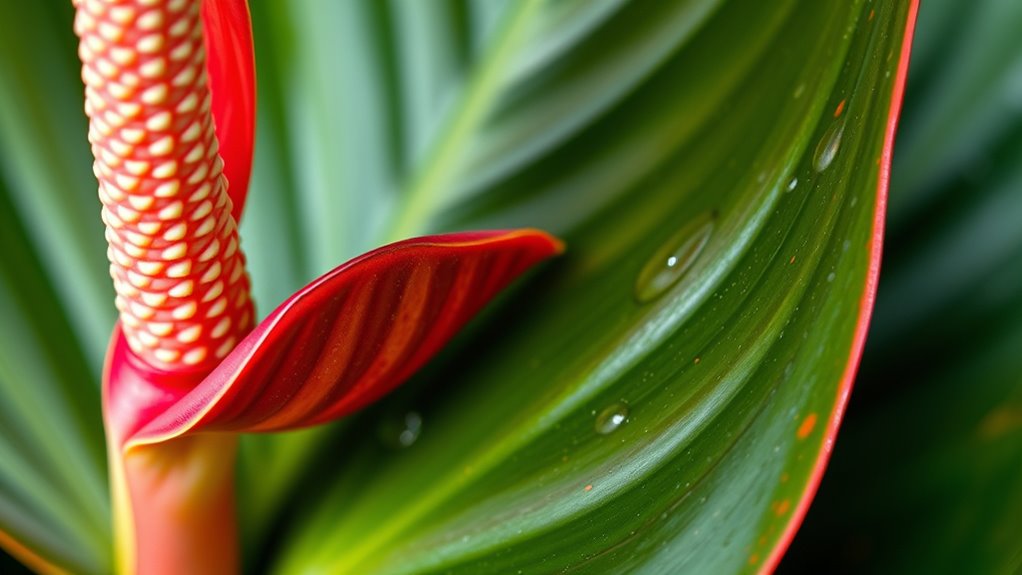
Implementing proper watering techniques is essential for maintaining healthy spadices. Overwatering can lead to root rot, while underwatering causes stress, both increasing browning risks. Guarantee soil stays evenly moist but drains well to promote soil aeration, which keeps roots healthy and prevents fungal issues. Regularly check moisture levels and avoid water accumulation. Additionally, maintain a balanced fertilizer schedule; too much nitrogen can encourage excessive leaf growth at the expense of spadix health, while insufficient nutrients weaken the plant. Use a fertilizer formulated for aroids, applying it at the recommended intervals. Proper soil aeration and fertilizer balance work together to strengthen your anthurium’s overall health, reducing the likelihood of browning and promoting vibrant, lively spadices. Monitoring your plant for signs of fungal infection and treating issues early can further safeguard your plant’s vitality. Ensuring proper butter storage conditions and avoiding temperature fluctuations can also help prevent stress-related issues that might impact your plant’s health.
Treatment Options for Browning Spadix

To treat a browning spadix, start by pruning affected areas at the right time to encourage healthy growth. Consider using fungicides if you notice signs of disease, but remember they aren’t always effective for all issues. Additionally, adjust your watering habits to avoid overwatering or underwatering, which can worsen the problem.
Pruning Techniques and Timing
When you notice the spadix of your anthurium turning brown, timely pruning can help prevent further damage and encourage healthy growth. The right pruning timing is essential; wait until the browning is clearly visible and the spadix is no longer vibrant. Use clean, sharp scissors or pruning shears to trim the affected area. Cut just above the base of the browning section, making a clean, angled cut to promote healing. Avoid tearing or damaging the healthy parts of the plant. Regular trimming techniques involve removing only the dead or decayed tissue, which reduces stress on the plant and minimizes infection risks. Pruning at the appropriate time ensures your anthurium stays healthy and vibrant, encouraging new growth and preventing browning from spreading.
Fungicide Treatments Effectiveness
Applying the right fungicide treatments can effectively combat browning caused by fungal infections in your anthurium’s spadix. To maximize success, choose a fungicide suited for ornamental plants and apply it carefully, following label instructions. Consistent treatment is key to preventing fungal spread. Additionally, guarantee proper fertilizer application to strengthen your plant’s defenses and reduce stress that can worsen infections. Pest control also plays a role, as pests can carry fungi or weaken your plant, making it more vulnerable. Consider these steps:
- Use targeted fungicides for fungal issues, applied at recommended intervals.
- Maintain ideal fertilization schedules to improve overall plant health.
- Monitor and control pests to prevent secondary infections.
Optimal Watering Practices
Proper watering is essential for preventing browning of your anthurium’s spadix, as both overwatering and underwatering can stress the plant and promote disease. Make certain the soil pH stays between 5.5 and 6.5, which helps roots absorb nutrients effectively, reducing stress that can cause browning. Water thoroughly when the top inch of soil feels dry, but avoid letting the plant sit in water, as this can lead to root rot. Maintain a balanced fertilizer regimen, using a formula with equal parts nitrogen, phosphorus, and potassium, to support healthy growth. Consistent watering practices and proper soil conditions help keep the spadix vibrant, preventing browning caused by water stress or nutrient imbalance.
When to Seek Professional Help

If your anthurium’s spadix continues to turn brown despite adjusting watering and lighting, it’s time to contemplate professional help. Persistent browning could signal underlying issues like pest infestations or nutrient deficiencies that you might not detect easily.
Consider seeking help if:
- You notice signs of pests, such as webbing or sticky residue, that don’t respond to treatment.
- The browning worsens despite improving care, indicating possible nutrient deficiencies or disease.
- You’re unsure about diagnosing or treating complex problems, especially if fungal or bacterial infections are suspected.
A professional can accurately diagnose issues and recommend targeted treatments, ensuring your plant’s health and preventing further damage. Don’t hesitate to consult an expert if basic care adjustments don’t improve your anthurium’s condition.
Tips for Maintaining a Vibrant, Healthy Anthurium

To keep your anthurium vibrant and healthy, focus on providing consistent care that supports its overall well-being. Start by ensuring proper soil composition; use a well-draining mix rich in organic matter to prevent waterlogging, which can lead to root rot. Regularly check for pests like aphids or mealybugs, and practice pest prevention by inspecting leaves and stems and using natural repellents or insecticidal soap when needed. Maintain a balanced watering schedule—allow the top inch of soil to dry out between waterings. Keep the plant in bright, indirect light and maintain proper humidity. Consistent monitoring and adjusting your care routine help prevent issues that can cause browning or decline, keeping your anthurium healthy and thriving.
Frequently Asked Questions
Can Pests Cause My Anthurium’S Spadix to Turn Brown?
Yes, pests can cause your anthurium’s spadix to turn brown. Pest damage often presents as discoloration, spots, or wilting, which are clear disease symptoms. When pests feed on your plant, they weaken the tissue, leading to browning and decay. Regularly inspect your anthurium for signs of pests like aphids or scale, and address infestations promptly to prevent further damage and keep your plant healthy.
Does Sunlight Exposure Influence Browning of the Spadix?
Think of your anthurium’s spadix as a delicate flame needing just the right amount of sunlight to glow. Too much sun can scorch it, causing browning, while too little hampers photosynthesis, leaving it dull and lifeless. Sunlight impact directly influences the health of the spadix—adequate light enhances growth, but overexposure can cause damage. Balance is key to keeping your plant vibrant and avoiding browning.
How Does Temperature Fluctuation Affect Spadix Health?
Temperature fluctuations can markedly impact your anthurium’s spadix health. Sudden temperature stress causes the plant to struggle, leading to browning or damage. High or low temps disrupt its growth, and humidity impact worsens this effect by drying out or overwatering the plant. Keep your anthurium in a stable, warm environment to prevent stress, and maintain consistent humidity levels to support healthy spadix development.
Can Fertilizers Cause Browning of the Anthurium Spadix?
You might think fertilizers help your anthurium, but they can actually cause browning if you’re not careful. Fertilizer burn damages roots and tissues, leading to a brown spadix, while nutrient deficiency from over-fertilizing can also make it turn brown. So, ironically, feeding your plant too much or too little can harm it. Always follow instructions and use balanced fertilizer to avoid this unintended damage.
Is It Normal for the Spadix to Change Color During Flowering?
During flowering stages, it’s normal for the spadix to experience color changes. As your anthurium blooms, the spadix may turn yellow, brown, or fade, signaling natural progression. These color changes indicate different flowering phases and aren’t usually a cause for concern. Keep an eye on overall plant health, guarantee proper watering, and enjoy the natural beauty of your anthurium’s evolving flowers.
Conclusion
Think of your anthurium as a delicate dance partner—you need to listen closely to its signals. When you notice browning, it’s like catching a misstep; it doesn’t have to ruin the dance. With proper watering, good airflow, and timely care, you can keep your plant thriving. Remember, just like learning a new move takes time, understanding your anthurium’s needs will help it stay vibrant and healthy for years to come.
